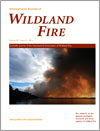
International Journal of Wildland Fire
Volume 20 Number 5 2011
WF09119Wildland fire spread modelling using cellular automata: evolution in large-scale spatially heterogeneous environments under fire suppression tactics
In this paper we present a Cellular Automata-based model able to predict the evolution of fire fronts, taking into account various factors including the landscape, vegetation, wind field, humidity, spotting effect and fire suppression tactics. The model has been applied successfully in approximating the dynamics of a large scale fire.
WF09042Alternative equations to estimate the surface-to-volume ratio of different forest fuel particles
WF10019The effects of wind on the flame characteristics of individual leaves
The effects of wind on burning live and dead single leaves and small cuttings were studied with regard to flame angle, flame height and flame length, as well as the times and temperatures corresponding to ignition, maximum flame height and burnout.
WF10083Fuel structural traits modulating soil temperatures in different species patches of Mediterranean Basin shrublands
The fine dead fuel accumulated in the canopy of some species and the bulk density of this canopy fuel are major fuel structural characteristics modulating soil temperatures in Mediterranean Basin shrublands. Management strategies that promote species with a low accumulation of fine dead fuel could be crucial to reducing the effect on the ecosystem of fires.
WF10005Landscape variables influencing forest fires in central Spain
We investigated the degree of selectivity of fires towards landscape variables like land-use–land-cover type, distance to roads or towns, and topographical characteristics in central Spain. We found that fires preferentially burned pine woodlands, areas at small or intermediate distance to roads, and at intermediate distance to roads.
WF10001Assessing the susceptibility of semiarid rangelands to wildfires using Terra MODIS and Landsat Thematic Mapper data
A study was designed to investigate prefire vegetation fuel load changes in the rangelands of south-east Idaho, USA. Satellite remote sensing techniques were used, and the study results demonstrate satellite imagery can be used to add substantial value to assess the susceptibility of rangelands to wildfire.
WF10044Recent trends in post-wildfire seeding in western US forests: costs and seed mixes
A review of scientific articles, government publications and unpublished documents as well as USDA Forest Service Burned Area Reports revealed a trend of increasing use of native species, annual cereal grains and sterile-grass hybrids. Total post-fire seeding expenditures have increased substantially. The percentage of the total burned area seeded has decreased, but the cost per hectare seeded has increased over time.
WF09127Rhus glabra response to season and intensity of fire in tallgrass prairie
A study of fire effects on expansion of the shrub Rhus glabra in grassland showed that autumn or winter burning, particularly with low-intensity backfires, produced lower shrub abundance over the long term, and may be an effective management tool for limiting R. glabra expansion. In addition, fire season indirectly affected shrub expansion by altering browsing rates.



